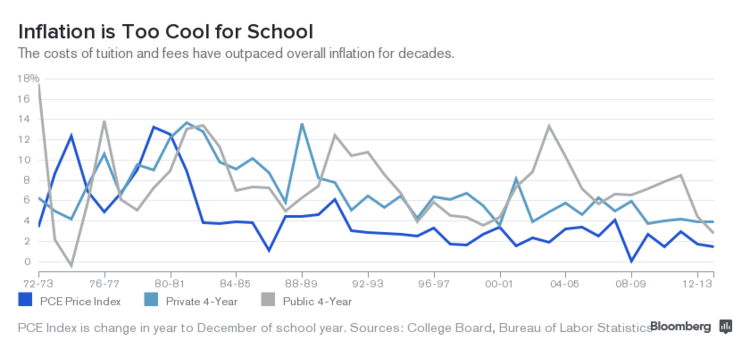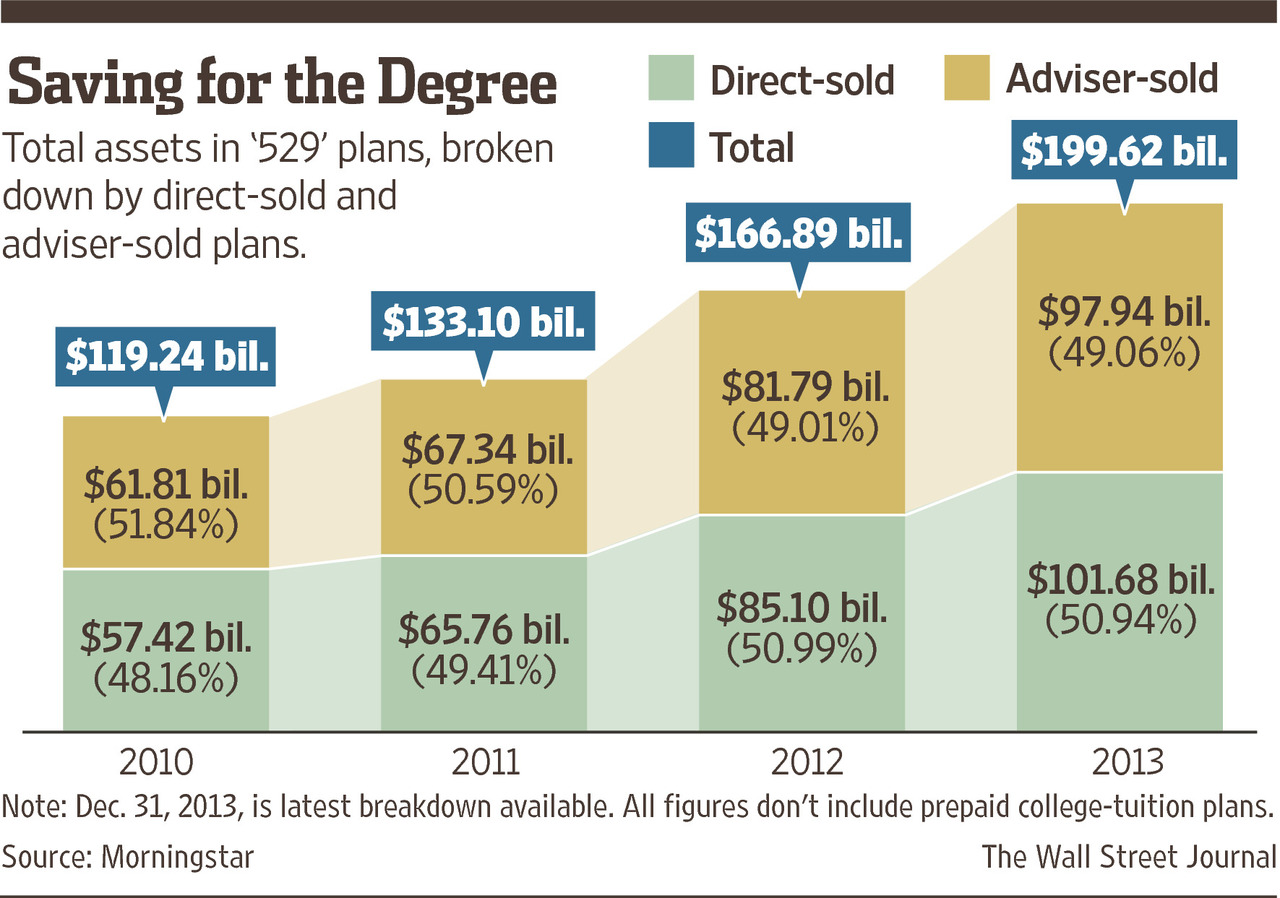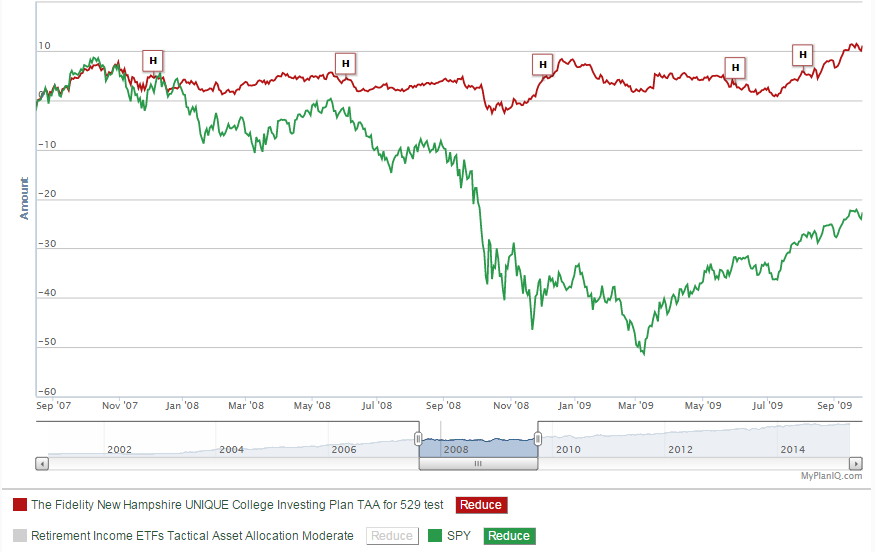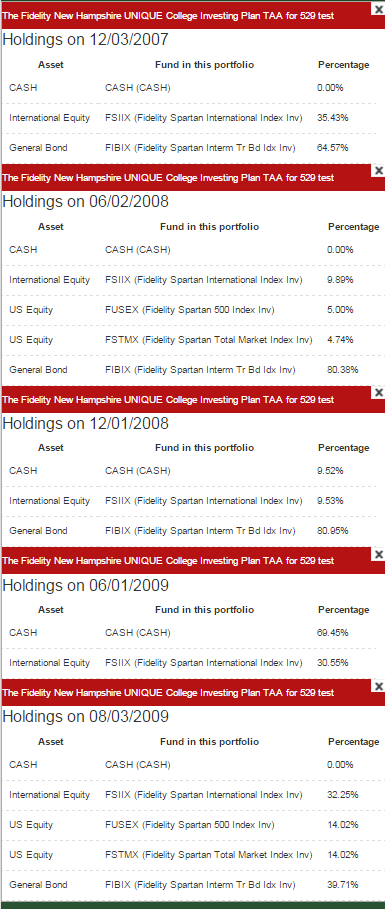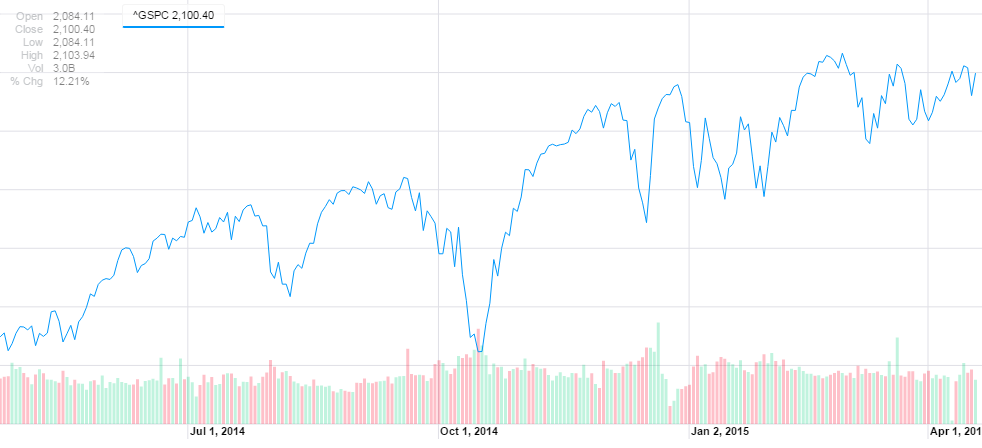Re-balance Cycle Reminder All MyPlanIQ’s newsletters are archived here.
For regular SAA and TAA portfolios, the next re-balance will be on Monday, May 18, 2015. You can also find the re-balance calendar for 2014 on ‘Dashboard‘ page once you log in.
As a reminder to expert users: advanced portfolios are still re-balanced based on their original re-balance schedules and they are not the same as those used in Strategic and Tactical Asset Allocation (SAA and TAA) portfolios of a plan.
Please note that we now list the next re-balance date on every portfolio page.
529 College Savings Plan Rebalance Policy Change
529 College Savings Plans have become more popular recently. There are several reasons behind it:
Outpacing inflation
Based on Bloomberg, the cost of college tuition and fees have outpaced inflation every year since early 80s. The cost of attending public university has risen more slowly recently while the gap between the cost of attending a private university and overall inflation has been held steady.
In fact, based on savingforcollege.com, the average historical cost increase rate in the past decade is about 5%:
| Type of Institution | Projected 4-Year Tuition and Fees | |
|---|---|---|
| Today (Enrolling 2015) |
In 18 Years (Enrolling 2033) |
|
| Private College | $134,600 | $323,900 |
| Public/University (in-state resident) | $39,400 | $94,800 |
| 2 Years Community College & 2 Years Private College | $77,400 | $186,400 |
(Based on average tuition and fees for 2014-2015 as reported by The College Board® and assumed to increase 5% annually.)
Markets have done well
For the past 5 years, stock and bond markets have done pretty well, boosting total 529 plan assets:
However, even though 529 plans have a distinct tax advantage, these plans are not without drawbacks. The most noticeable ones are
- Higher cost: According to the Financial Research Corporation, a typical 529 plan offered through a state has an average annual fee of 0.69%, whereas a 529 sold through a broker has an average annual fee of 1.17%. These fees are very high, compared with a low cost plan/portfolio one can construct using index ETFs (for example, the average fund expense ratio in MyPlanIQ’s Six Core Asset ETFs is 0.22% while that in MyPlanIQ Diversified Core Allocation ETF Plan is 0.25%).
- Limited fund choices: some plans have limited asset coverage. Many of them have no funds in REITs or emerging market stocks.
- Limited rebalance frequency: before the recent change, 529 plans allowed once per calendar year rebalance. It is extremely hard to implement a portfolio that can respond to market conditions, especially during market stress to avoid big loss.
Because of the above restrictions, we are not a big fan of using 529 plans for average investors. However, we do recognize that these plans do offer good values to certain groups of investors.
Recent Rebalance Policy Change
Beginning this year, the once per year rebalance policy has been loosened to twice per year (see The Wall Street Journal report cited by one of our users, thank you!). We have since modified our Tactical Asset Allocation (TAA) and Strategic Asset Allocation – Optimal (SAA) accordingly. For SAA, the modification is really not substantial: in general, because of the limited fund choices in a 529 plan, we believe the best rebalance frequency is once per year or at most twice per year. However, for TAA, the change has addressed one of the major concerns: the inflexibility to make substantial asset allocation change. In fact, the old once per year rebalance limitation has been the main reason for us not to recommend using TAA for a 529 plan.
So is twice a year good enough for a TAA portfolio?
The following table shows the back test (and live – for current portfolios) performance comparison between the current TAA and modified TAA (using twice a year rebalance) portfolios. The modified TAA portfolios are those whose names end with ‘for 529 test’:
Portfolio Performance Comparison (as of 4/17/2015):
The detailed year by year comparison >>
Notice other than MFS Oregon 529 plan, all the other 4 portfolios have noticeable return improvement for the past 10 years. Looking closely at Fidelity New Hampshire plan, we notice that the modified TAA portfolio behaved better in 2008-2009:
Holdings:
The increased flexibility does help in 2008-2009 period: even though the portfolio was not entirely out of equity in 2008. It had an extra chance in December 2008 to further reduce equity exposure and then in August 2009 to start to get back to fully invest in equities.
Notice we use a heuristic to decide when to make rebalances during a calendar year to fully take advantage of the two possible rebalance chances. The dates of rebalances are not fixed but they fall into one of the 12 rebalance dates on our rebalance calendar for a normal SAA or TAA.
Similarly, the modified SAA shows a similar improvement:
Portfolio Performance Comparison (as of 4/20/2015):
We caution that we have not replaced the TAA and SAA strategies to make the newly modified strategies official. We expect this will be done before the next rebalance.
To summarize, we believe the loosen rebalance policy is a big improvement. However, we are still not entirely comfortable with the restriction. In general, for those who need to have college savings in a short time frame (such as within 5-7 years), we suggest a more conservative allocation style to cope with market downturns.
Market Overview
US stock markets rose again to recover from some meaningful sell off last week. International and emerging market stocks have shown some strength recently. We do make a note that since the beginning of this year, S&P 500 has experienced more frequent periodic “vibrations”:
For now, risk assets are still in an up trend.
For more detailed asset trend scores, please refer to 360° Market Overview.
We would like to remind our readers that markets are more precarious now than other times in the last 5 years. It is a good time and imperative to adjust to a risk level you are comfortable with right now. However, recognizing our deficiency to predict the markets, we will stay on course.
We again copy our position statements (from previous newsletters):
Our position has not changed: We still maintain our cautious attitude to the recent stock market strength. Again, we have not seen any meaningful or substantial structural change in the U.S., European and emerging market economies. However, we will let markets sort this out and will try to take advantage over its irrational behavior if it is possible.
We again would like to stress for any new investor and new money, the best way to step into this kind of markets is through dollar cost average (DCA), i.e. invest and/or follow a model portfolio in several phases (such as 2 or 3 months) instead of the whole sum at one shot.
Latest Articles
- April 13, 2015: Total Return Bond Funds As Smart Cash
- April 6, 2015: The Low Return Environment
- March 30, 2015: Brokerage Specific Core Mutual Fund Portfolios 2
- March 23, 2015: Investment Arithmetic for Long Term Investments
- March 16, 2015: Brokerage Specific Core Mutual Fund Portfolios
- March 9, 2015: Newsletter Collection Update
- March 2, 2015: Total Return Bond ETFs
- February 23, 2015: Why Is Global Tactical Asset Allocation Not Popular?
- February 16, 2015: Where Are Permanent Portfolios Going?
- February 9, 2015: How Have Asset Allocation Funds Done?
- February 2, 2015: Risk Management Everywhere
- January 26, 2015: Composite Portfolios Review
- January 19, 2015: Fixed Income Investing Review
- January 12, 2015: How Does Trend Following Tactical Asset Allocation Strategy Deliver Returns
- January 5, 2015: When Forecast Fails
- December 22, 2014: Long Term Asset Returns: How Long Is Long?
- December 15, 2014: Beaten Down Assets
- December 8, 2014: Implementing Core Asset Portfolios In a Brokerage
- December 1, 2014: Two Key Issues of Investment Strategies
- November 24, 2014: Holiday Readings
- November 17, 2014: Retirement Spending Portfolios Update
- November 10, 2014: Fixed Income Or Cash
- November 3, 2014: Asset Trend Review
- October 27, 2014: Investment Loss, Mistakes And Market Cycles
- October 20, 2014: Strategic Portfolios With Managed Volatility
- October 13, 2014: Embrace Volatility
- October 6, 2014: Tips For 401k Open Enrollment
- September 29, 2014: What Can We Learn From Bill Gross’ Departure From PIMCO?
- September 22, 2014: Why Total Return Bond Funds?
- September 15, 2014: Equity And Total Return Bond Fund Composite Portfolios
- September 8, 2014: Momentum Based Portfolios Review
- September 1, 2014: Risk & Diversification: Mint.com Interview
- August 25, 2014: Remember Risk
- August 18, 2014: Consistency, The Most Important Edge In Investing: Tactical Case
- August 11, 2014: What To Do In Overvalued Stock Markets
- August 4, 2014: Is This The Peak Or Correction?
- July 28, 2014: Stock Musings
- July 21, 2014: Permanent Portfolios & Four Pillar Foundation Based Framework
- July 14, 2014: Composite Portfolios Review
- July 7, 2014: Portfolio Behavior During Market Corrections
- June 30, 2014: Half Year Brokerage ETF and Mutual Fund Portfolios Review
- June 23, 2014: Newsletter Collection Update
- June 16, 2014: There Are Always Lottery Winners
- June 9, 2014: The Arithmetic of Investment Mistakes
- June 2, 2014: Tips On Portfolio Rebalance
- May 26, 2014: In Praise Of Low Cost Core Asset Class Based Portfolios
- May 19, 2014: Consistency, The Most Important Edge In Investing: Strategic Case
- May 12, 2014: How To Handle An Elevated Overvalued Market
- May 5, 2014: Asset Allocation Funds Review
- April 28, 2014: Now The Economy Backs To The ‘Old Normal’, Should Our Investments Too?
- April 21, 2014: Total Return Bond Investing In The Current Market Environment
Enjoy Newsletter
How can we improve this newsletter? Please take our survey
–Thanks to those who have already contributed — we appreciate it.

